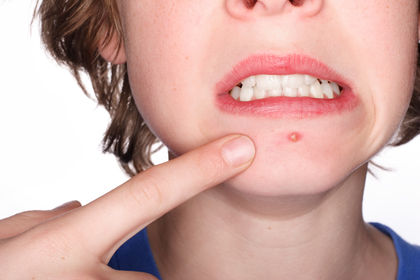Puberty

In humans, puberty is the period of physical development when sexual reproduction can first take place. It is characterized by maturity of the sexual organs and the development of secondary sexual characteristics (such as the deepening of a boy's voice or the development of a girl's breasts). The beginning of menstruation in females also begins in puberty. (Menstruation is the monthly cycle of the shedding of the lining of the uterus in women who are not pregnant.) The growth spurt experienced in puberty is characteristic of primates. Although other mammals may have increased reproductive organ growth, their overall size does not increase as dramatically.
Puberty marks the physical transition from childhood to adulthood. It usually occurs between the ages of 10 and 16, with females entering the stage earlier than males. Both sexes experience considerable increases in body height and weight during this period and require a balanced, nutritious diet with sufficient calories for optimal growth. Puberty usually lasts from two to five years and may be accompanied by emotional ups and downs.
Sexual development during puberty is regulated by the release of hormones (chemicals produced by the body that affect various bodily processes). The major control center that regulates the release of hormones in humans is the hypothalamus (a gland in the brain). The release of the hormone testosterone during puberty is associated with more aggressive behavior in males. Increases in estrogen (in females) and testosterone is associated with an increased sex drive, or libido.
Male puberty
During male puberty, the hypothalamus secretes hormones that stimulate the pituitary gland to release gonadotrophic hormones, which consist of follicle-stimulating hormone (FSH) and luteinizing hormone (LH). FSH stimulates development of the tubes in the testes in which sperm production takes place and is thought to be involved in sperm maturation. LH stimulates the testes to release testosterone. In males, puberty is marked by enlargement of the testicles and penis, lengthening of the vocal cords, which causes the voice to deepen, and growth of pubic hair. Facial hair may also begin to appear on the face, chest, and abdomen.
Female puberty
In females, puberty begins with the development of breasts and widening of the hips. Breast development can begin as early as 8 years
Words to Know
Estrogens: Female sex hormones produced by the ovaries and involved in the development of reproductive organs and secondary sexual characteristics.
Fertility: The ability to produce offspring.
Hormone: A chemical produced in one part of the body that stimulates cellular activity in other body parts.
Hypothalamus: A part of the brain that regulates the production of hormones by the pituitary gland.
Menstruation: The cyclic shedding of the lining of the uterus in fertile women who do not become pregnant.
Ovary: One of a pair of female reproductive organs that produces eggs and sex hormones.
Pituitary gland: A gland located beneath the hypothalamus in the brain that secretes hormones controlling various bodily processes.
Primates: Mammals including monkeys, apes, and humans that have highly developed brains and hands with thumbs that are adapted for grasping.
Sperm: A male reproductive cell; semen.
Testes: The male reproductive organs that produce sperm and testosterone.
Testosterone: A male sex hormone that stimulates sperm production and is responsible for male sex characteristics.
of age but usually starts between 10 and 14. Full breast development may take two to five years. Pubic hair begins to grow shortly afterwards, followed by the first menstrual period, usually occurring between the ages of 10 and 14. Like male puberty, female puberty is initiated by hypothalamic hormones that stimulate the release of FSH and LH from the pituitary. FSH stimulates the development of follicles (sacs of cells in the ovaries in which eggs mature) and the secretion of reproductive hormones known as estrogens by the ovaries. Estrogens are involved in the growth of the uterus, development of the breasts, widening of the hips, and the distribution of fat and muscle. LH stimulates ovulation (the release of an egg from an ovary).
Sex and fertility
Puberty is a time when males and females begin to think about their sexuality and sexual activity. With sexual maturation comes fertility, meaning that females are now able to become pregnant and males' sperm are able to impregnate a female. Although teenagers' bodies may be sexually mature, the emotional maturity needed to engage in sexual activity and childrearing usually takes longer to develop.
[ See also Endocrine system ; Hormone ; Reproductive system ]
Personally, I am a teen and experiencing these changes. I love y'all and your knowledge about these things!